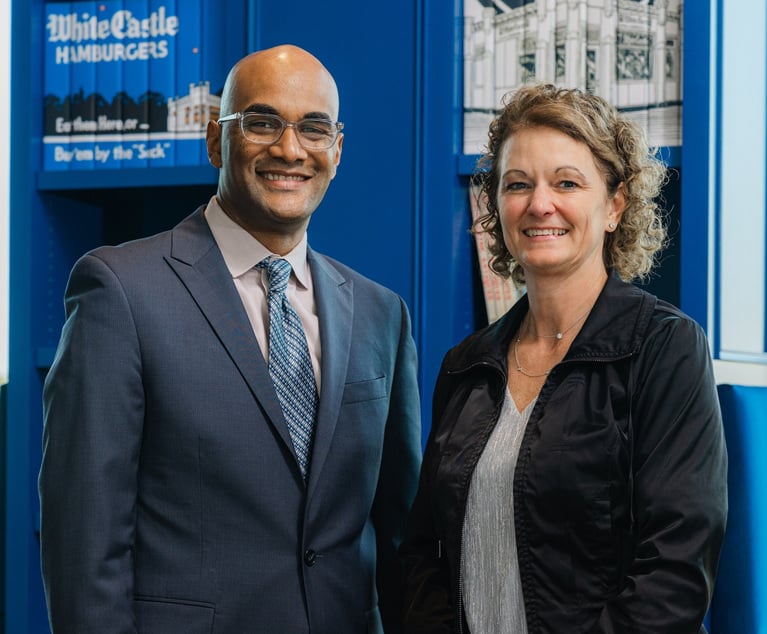Tweeting Your Way in the Door
Silly name, powerful tool for your career.
April 13, 2011 at 08:00 PM
12 minute read
The original version of this story was published on Law.com
Attorneys understand the law of unintended consequences. Typically, we associate that term with well-intentioned regulations that end up incentivizing undesired behavior. With respect to Twitter, a very different kind of unintended consequence has firmly taken hold. As the young men who founded Twitter discussed on a recent episode of Piers Morgan Tonight , Twitter's original purpose had nothing to do with business or politics. Yet, the world is witnessing the power of this communication medium as a facilitator of free speech in the Middle East.
I confess that, until recently, I never considered the possibility of Twitter as an asset for either my business or for attorneys in job search mode. I'm just beginning to experience the business value of Twitter personally, and I encourage you to “follow” me at @everslegal. And for an excellent example of how internal recruiters at cutting edge companies are using Twitter to post new openings, follow @danjessup. While this example from Groupon is not specific to attorneys, you'll get the idea.
But now let's focus on how you can use Twitter to build a personal brand and get in the door for high-value introductions. Making Twitter useful for your career involves three steps: 1. Get the right people to “follow” you. I'll explain how. 2. Create the right messaging. 3. Follow-up using old fashioned technology, such as a telephone.
For step one, begin with the basics of any high quality job search. That is, research the names of likely decision-makers at your target employers, whether they are non-lawyer executives, a general counsel or an HR person. Open a Twitter account. Then, use the search feature to identify the Twitter accounts of decision-makers. They won't all have one, of course, but work with what you find. You will be surprised at how many businesspeople have Twitter accounts. Then, select the option to “follow” these individuals. If all you do is read their “tweets,” the insights you gain will help you to tailor messages and resumes you will be sending via email or pony express. You will also discover that a lot of these individuals will then choose to “follow” you.
For step two, start to tweet and experiment a bit to find your own comfort zone. Generally, you want to avoid personal “Facebook” type updates. Absolutely no one cares about the hotel you stayed in last night or how United Airlines lost your luggage. That may be what Twitter's founders intended, but avoid the temptation of falling into Twitter use for that kind of personal nonsense. It creates clutter and makes it less likely that people will read future messages from you. Similarly, don't become a serial tweeter who sends out several messages per day. I recommend no more than two tweets in a day, and I think one is better. On the other hand, you don't want to tweet infrequently. Your goal is to become a source of interesting information on a regular basis. On frequency, I recommend three to five tweets per week, preferably on weekdays. Again, think about this as business communication.
When creating your tweets, think along the lines of information that is both interesting for the intended audience and that will help brand you as an expert. I will give “props” here to Andrew Slobodien, an employment law partner at Wildman Harrold who grasped Twitter's value long before I paid attention. Follow him at @LaborLawLawyer. What a great account name! You will see that Andrew primarily tweets very timely case updates and interesting content to help his clients and attract potential clients. Your tweets could be on the topic of law department management, best practices for serving internal business clients or regulatory updates of interest to senior business leaders. Those are obviously just examples. Challenge yourself to be relevant.
The highest value of Twitter, as with any marketing activity, is personal branding over the long haul. Ideally, people will be making direct contact with you over time. So, the best time to start using Twitter is when you are not in a rush to land a new job. That's the same rule of thumb for any kind of networking-oriented activity; it should be a constant and not just something you do when you need a job. Nonetheless, I'm going to add a third step to this column, intended specifically for readers who are simply not in a position to exercise that kind of patience.
So, for those in active job search mode, take a more aggressive approach and use the information you read, and send, on Twitter as hooks for direct communication attempts. This is step three. Begin with a direct user-to-user email via Twitter. But I encourage you to brave phone calls as well. How about that for the ultimate unintended consequence of Twitter? Call a potential decision-maker who is “following” you on Twitter with a coffee or lunch invitation. Your “pitch” is to enjoy a conversation of mutual interest and make a personal introduction. Avoid the term informational interview, as your listener will only hear the word interview and you will be routed to a red tape filled black hole. As with all contacts of this kind, you will get several “no” replies for every “yes.” Regardless of communication medium, there is no way around the rejection that comes with a full throttle job search. But Twitter (yes, Twitter!) is a great tool for turning cold calls into warm calls.
Attorneys understand the law of unintended consequences. Typically, we associate that term with well-intentioned regulations that end up incentivizing undesired behavior. With respect to Twitter, a very different kind of unintended consequence has firmly taken hold. As the young men who founded Twitter discussed on a recent episode of Piers Morgan Tonight , Twitter's original purpose had nothing to do with business or politics. Yet, the world is witnessing the power of this communication medium as a facilitator of free speech in the Middle East.
I confess that, until recently, I never considered the possibility of Twitter as an asset for either my business or for attorneys in job search mode. I'm just beginning to experience the business value of Twitter personally, and I encourage you to “follow” me at @everslegal. And for an excellent example of how internal recruiters at cutting edge companies are using Twitter to post new openings, follow @danjessup. While this example from Groupon is not specific to attorneys, you'll get the idea.
But now let's focus on how you can use Twitter to build a personal brand and get in the door for high-value introductions. Making Twitter useful for your career involves three steps: 1. Get the right people to “follow” you. I'll explain how. 2. Create the right messaging. 3. Follow-up using old fashioned technology, such as a telephone.
For step one, begin with the basics of any high quality job search. That is, research the names of likely decision-makers at your target employers, whether they are non-lawyer executives, a general counsel or an HR person. Open a Twitter account. Then, use the search feature to identify the Twitter accounts of decision-makers. They won't all have one, of course, but work with what you find. You will be surprised at how many businesspeople have Twitter accounts. Then, select the option to “follow” these individuals. If all you do is read their “tweets,” the insights you gain will help you to tailor messages and resumes you will be sending via email or pony express. You will also discover that a lot of these individuals will then choose to “follow” you.
For step two, start to tweet and experiment a bit to find your own comfort zone. Generally, you want to avoid personal “Facebook” type updates. Absolutely no one cares about the hotel you stayed in last night or how
When creating your tweets, think along the lines of information that is both interesting for the intended audience and that will help brand you as an expert. I will give “props” here to Andrew Slobodien, an employment law partner at
The highest value of Twitter, as with any marketing activity, is personal branding over the long haul. Ideally, people will be making direct contact with you over time. So, the best time to start using Twitter is when you are not in a rush to land a new job. That's the same rule of thumb for any kind of networking-oriented activity; it should be a constant and not just something you do when you need a job. Nonetheless, I'm going to add a third step to this column, intended specifically for readers who are simply not in a position to exercise that kind of patience.
So, for those in active job search mode, take a more aggressive approach and use the information you read, and send, on Twitter as hooks for direct communication attempts. This is step three. Begin with a direct user-to-user email via Twitter. But I encourage you to brave phone calls as well. How about that for the ultimate unintended consequence of Twitter? Call a potential decision-maker who is “following” you on Twitter with a coffee or lunch invitation. Your “pitch” is to enjoy a conversation of mutual interest and make a personal introduction. Avoid the term informational interview, as your listener will only hear the word interview and you will be routed to a red tape filled black hole. As with all contacts of this kind, you will get several “no” replies for every “yes.” Regardless of communication medium, there is no way around the rejection that comes with a full throttle job search. But Twitter (yes, Twitter!) is a great tool for turning cold calls into warm calls.
This content has been archived. It is available through our partners, LexisNexis® and Bloomberg Law.
To view this content, please continue to their sites.
Not a Lexis Subscriber?
Subscribe Now
Not a Bloomberg Law Subscriber?
Subscribe Now
NOT FOR REPRINT
© 2025 ALM Global, LLC, All Rights Reserved. Request academic re-use from www.copyright.com. All other uses, submit a request to [email protected]. For more information visit Asset & Logo Licensing.
You Might Like
View All
White Castle GC Becomes Chain's First President From Outside Family

Beyond the Title: Developing a Personal Brand as General Counsel
Trending Stories
Who Got The Work
Michael G. Bongiorno, Andrew Scott Dulberg and Elizabeth E. Driscoll from Wilmer Cutler Pickering Hale and Dorr have stepped in to represent Symbotic Inc., an A.I.-enabled technology platform that focuses on increasing supply chain efficiency, and other defendants in a pending shareholder derivative lawsuit. The case, filed Oct. 2 in Massachusetts District Court by the Brown Law Firm on behalf of Stephen Austen, accuses certain officers and directors of misleading investors in regard to Symbotic's potential for margin growth by failing to disclose that the company was not equipped to timely deploy its systems or manage expenses through project delays. The case, assigned to U.S. District Judge Nathaniel M. Gorton, is 1:24-cv-12522, Austen v. Cohen et al.
Who Got The Work
Edmund Polubinski and Marie Killmond of Davis Polk & Wardwell have entered appearances for data platform software development company MongoDB and other defendants in a pending shareholder derivative lawsuit. The action, filed Oct. 7 in New York Southern District Court by the Brown Law Firm, accuses the company's directors and/or officers of falsely expressing confidence in the company’s restructuring of its sales incentive plan and downplaying the severity of decreases in its upfront commitments. The case is 1:24-cv-07594, Roy v. Ittycheria et al.
Who Got The Work
Amy O. Bruchs and Kurt F. Ellison of Michael Best & Friedrich have entered appearances for Epic Systems Corp. in a pending employment discrimination lawsuit. The suit was filed Sept. 7 in Wisconsin Western District Court by Levine Eisberner LLC and Siri & Glimstad on behalf of a project manager who claims that he was wrongfully terminated after applying for a religious exemption to the defendant's COVID-19 vaccine mandate. The case, assigned to U.S. Magistrate Judge Anita Marie Boor, is 3:24-cv-00630, Secker, Nathan v. Epic Systems Corporation.
Who Got The Work
David X. Sullivan, Thomas J. Finn and Gregory A. Hall from McCarter & English have entered appearances for Sunrun Installation Services in a pending civil rights lawsuit. The complaint was filed Sept. 4 in Connecticut District Court by attorney Robert M. Berke on behalf of former employee George Edward Steins, who was arrested and charged with employing an unregistered home improvement salesperson. The complaint alleges that had Sunrun informed the Connecticut Department of Consumer Protection that the plaintiff's employment had ended in 2017 and that he no longer held Sunrun's home improvement contractor license, he would not have been hit with charges, which were dismissed in May 2024. The case, assigned to U.S. District Judge Jeffrey A. Meyer, is 3:24-cv-01423, Steins v. Sunrun, Inc. et al.
Who Got The Work
Greenberg Traurig shareholder Joshua L. Raskin has entered an appearance for boohoo.com UK Ltd. in a pending patent infringement lawsuit. The suit, filed Sept. 3 in Texas Eastern District Court by Rozier Hardt McDonough on behalf of Alto Dynamics, asserts five patents related to an online shopping platform. The case, assigned to U.S. District Judge Rodney Gilstrap, is 2:24-cv-00719, Alto Dynamics, LLC v. boohoo.com UK Limited.
Featured Firms
Law Offices of Gary Martin Hays & Associates, P.C.
(470) 294-1674
Law Offices of Mark E. Salomone
(857) 444-6468
Smith & Hassler
(713) 739-1250








